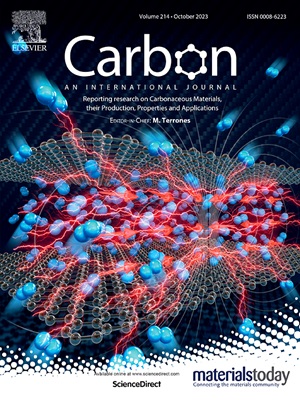基于固态生物聚合物电解质的n掺杂碳纳米管-石墨烯纳米结构电极用于高性能柔性超级电容器
IF 11.6
2区 材料科学
Q1 CHEMISTRY, PHYSICAL
引用次数: 0
摘要
石墨烯-碳纳米管复合材料合成复杂、产率低、界面接触弱等缺点限制了其电化学性能。同样,聚合物基固体电解质表现出低离子电导率和机械强度。为了克服这些问题,本研究开发了一种成本效益高、可扩展的单步CVD工艺,将一维双壁碳纳米管(DWNTs)与二维氮掺杂石墨烯纳米片互连,收率达到95.4%。所得的N-DWNTs/石墨烯混合电极具有高导电性,在2 a /g和50 a /g时的比电容分别为697.8 F/g和589 F/g。此外,还设计了一种固体电解质,将95% [BMIM][TFSI]的离子液体掺入甲基纤维素-淀粉生物聚合物混合物中,具有高离子电导率、机械稳定性、宽工作电压和温度范围。组装的柔性非对称超级电容器,将N-DWNTs/石墨烯作为负极,将N-DWNTs/石墨烯/Fe3O4@PANi作为正极,提供了187.8 Wh/kg的能量密度,3.8 kW/kg的功率密度,以及出色的循环稳定性(循环15,000次后97.4%)。它在1000次弯曲循环后保持97.5%的电容,并在0°C至90°C范围内有效工作。这些结果显示了下一代柔性储能设备的巨大潜力。本文章由计算机程序翻译,如有差异,请以英文原文为准。

N-doped carbon nanotube-graphene nanoarchitecture electrodes with solid-state biopolymer electrolyte for high performance flexible supercapacitors
Graphene–carbon nanotube composites often suffer from complex synthesis, low yield, and weak interfacial contact, limiting their electrochemical performance. Similarly, polymer-based solid electrolytes exhibit low ionic conductivity and mechanical strength. To overcome these issues, in this study, a cost-effective, scalable single-step CVD process was developed to interconnect 1D double-walled carbon nanotubes (DWNTs) with 2D nitrogen-doped graphene nanosheets, achieving a high yield of 95.4 %. The resulting N-DWNTs/graphene hybrid electrode exhibits high conductivity and a specific capacitance of 697.8 F/g at 2 A/g and 589 F/g at 50 A/g. A solid electrolyte was also designed using a 95 % [BMIM][TFSI] ionic liquid incorporated into a methylcellulose–starch biopolymer blend, offering high ionic conductivity, mechanical stability, and broad operating voltage and temperature ranges. The assembled flexible asymmetric supercapacitor, combining N-DWNTs/graphene as the negative electrode and N-DWNTs/graphene/Fe3O4@PANi as the positive electrode, delivers an energy density of 187.8 Wh/kg, a power density of 3.8 kW/kg, and excellent cycling stability (97.4 % after 15,000 cycles). It retains 97.5 % capacitance after 1000 bending cycles and operates effectively from 0 °C to 90 °C. These results demonstrate significant potential for next-generation flexible energy storage devices.
求助全文
通过发布文献求助,成功后即可免费获取论文全文。
去求助
来源期刊

Carbon
工程技术-材料科学:综合
CiteScore
20.80
自引率
7.30%
发文量
0
审稿时长
23 days
期刊介绍:
The journal Carbon is an international multidisciplinary forum for communicating scientific advances in the field of carbon materials. It reports new findings related to the formation, structure, properties, behaviors, and technological applications of carbons. Carbons are a broad class of ordered or disordered solid phases composed primarily of elemental carbon, including but not limited to carbon black, carbon fibers and filaments, carbon nanotubes, diamond and diamond-like carbon, fullerenes, glassy carbon, graphite, graphene, graphene-oxide, porous carbons, pyrolytic carbon, and other sp2 and non-sp2 hybridized carbon systems. Carbon is the companion title to the open access journal Carbon Trends. Relevant application areas for carbon materials include biology and medicine, catalysis, electronic, optoelectronic, spintronic, high-frequency, and photonic devices, energy storage and conversion systems, environmental applications and water treatment, smart materials and systems, and structural and thermal applications.
 求助内容:
求助内容: 应助结果提醒方式:
应助结果提醒方式:


